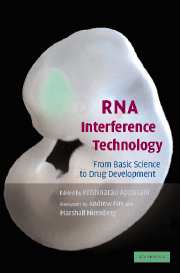Book contents
- Frontmatter
- Contents
- Foreword by Andrew Fire
- Foreword by Marshall Nirenberg
- List of Contributors
- Introduction
- Section one Basic RNAi, siRNA, microRNAs and gene-silencing mechanisms
- Section two Design, synthesis of siRNAs
- Section three Vector development and in vivo, in vitro and in ovo delivery methods
- Section four Gene silencing in model organisms
- Section five Drug target validation
- 22 Delivering siRNA in vivo for functional genomics and novel therapeutics
- 23 The role of RNA interference in drug target validation: Application to Hepatitis C
- 24 RNAi and the drug discovery process
- 25 RNA interference technology in the discovery and validation of druggable targets
- Section six Therapeutic and drug development
- Section seven High-throughput genome-wide RNAi analysis
- Index
- Plate section
- References
25 - RNA interference technology in the discovery and validation of druggable targets
Published online by Cambridge University Press: 31 July 2009
- Frontmatter
- Contents
- Foreword by Andrew Fire
- Foreword by Marshall Nirenberg
- List of Contributors
- Introduction
- Section one Basic RNAi, siRNA, microRNAs and gene-silencing mechanisms
- Section two Design, synthesis of siRNAs
- Section three Vector development and in vivo, in vitro and in ovo delivery methods
- Section four Gene silencing in model organisms
- Section five Drug target validation
- 22 Delivering siRNA in vivo for functional genomics and novel therapeutics
- 23 The role of RNA interference in drug target validation: Application to Hepatitis C
- 24 RNAi and the drug discovery process
- 25 RNA interference technology in the discovery and validation of druggable targets
- Section six Therapeutic and drug development
- Section seven High-throughput genome-wide RNAi analysis
- Index
- Plate section
- References
Summary
The role of gene suppression technologies in pharmaceutical drug development
The completion of the human genome sequence (International Human Genome Sequencing Consortium, 2001; Venter et al., 2001) has ushered in a new era for the pharmaceutical industry. With access to a comprehensive list of candidate drug targets, together with a growing understanding of their association to signalling and metabolic pathways and human disease, there would seem to be endless opportunity for novel drug development. From a clinical perspective, this most basic of genetic insights should enhance the efficacy of existing drugs, while at the same time bring new drugs to market for many new therapeutic indications. From a corporate vantage, utilising the information embedded in the human genome for improved target validation should effectively reduce the attrition of candidate drug targets and therefore translate to a “competitive advantage.”
With thousands of candidate drug targets to select from, it is necessary to invest in strategic methods in order to navigate the complex maze of genetic information. Indeed, the identification and validation of targets that map to chemically tractable gene families (the ‘druggable’ genome, or ‘pharmome’) is now recognised as a fundamental challenge to the entire pharmaceutical industry (Figure 25.1). In an effort to achieve this goal, molecular technologies that suppress the expression of a candidate drug target (either in cis- or trans-) have become fixtures in most pharmaceutical R&D programmes, and there are many examples where this has been successful.
- Type
- Chapter
- Information
- RNA Interference TechnologyFrom Basic Science to Drug Development, pp. 347 - 360Publisher: Cambridge University PressPrint publication year: 2005

